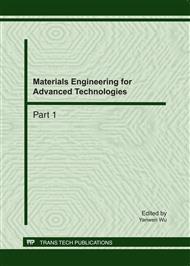[1]
FAO/WHO Experts' Report. Guidelines for the Evaluation of Probiotics in Food, Report of a Joint FAO/WHO Working Group on Drafting Guidelines for the Evaluation of Probiotics in Food, London Ontario, Canada, April 30 and May 1, (2002).
Google Scholar
[2]
Nancy Toedter Williams. Probiotics,. Am J Health-Syst Pharm. Vol 67(2010), p.449.
Google Scholar
[3]
Senok AC, Ismaeel AY, Botta GA. Probiotics: facts and myths. Clin Microbiol Infect. Vol. 11(2005), p.95.
Google Scholar
[4]
Doron S, Gorbach SL. Probiotics: their role in the treatment and prevention of disease. Expert Rev Anti Infect Ther. Vol. 4(2006), p.261.
Google Scholar
[5]
Wald A, Rakel D. Behavioral and complementary approaches for the treatment of irritable bowel syndrome. Nutr Clin Pract. Vol. 23(2008), p.284.
DOI: 10.1177/0884533608318677
Google Scholar
[6]
Surawicz CM. Role of probiotics in antibiotic-associated diarrhea, Clostridium difficile-associated diarrhea, and recurrent Clostridium difficile-associated diarrhea. J Clin Gastroenterol. Vol. 42(2008), p. S64.
DOI: 10.1097/mcg.0b013e3181646d09
Google Scholar
[7]
MacIntyre A, Cymet TC. Probiotics: the benefits of bacterial cultures. Compr Ther. Vol. 31(2005), p.181.
Google Scholar
[8]
Farnworth ER. The evidence to support health claims for probiotics. J Nutr. Vol. 138(2008), p.1250.
Google Scholar
[9]
Combarieu E. D, Fuzzati N, Lovati M, calli E.M. Furostanol saponins from Tribulus terrestris. Fitoterapia, Vol. 74(2003), p.583.
DOI: 10.1016/s0367-326x(03)00152-7
Google Scholar
[10]
Ali M. Sharifi, Radbod Darabi, Nasrin Akbarloo. Study of antihypertensive mechanism of Tribulus terrestris in 2KlC hypertensive rats: Role of tissue ACE activity. Life Sciences, Vol. 73(2003), p.2963–2971.
DOI: 10.1016/j.lfs.2003.04.002
Google Scholar
[11]
Joshia V.S., Parekha B.B., Joshia M.J. & Vaidya A.B. Herbal extracts of Tribulus terrestris and Bergenia ligulata inhibit growth of calcium oxalate monohydrate crystals in vitro. Journal of Crystal Growth, Vol. 275(2005), p.1403.
DOI: 10.1016/j.jcrysgro.2004.11.240
Google Scholar
[12]
Fang S., Hao C., Liu Z., Song F., Liu S. Application of electrospray ionization mass spectrometry combined with sequential tandem mass spectrometry techniques for the profiling of steroidal saponin mixture extracted from Tribulus terrestris. Planta Med, Vol. 65(1999).
DOI: 10.1055/s-1999-13966
Google Scholar
[13]
Kostova I, Dinchev D, Rentsch GH, Dimitrov V, Ivanova A. Two New Sulfated Furostanol Saponins from Tribulus terrestris. Z Naturforsch, Vol. 57(2002), p.33.
DOI: 10.1515/znc-2002-1-206
Google Scholar
[14]
Kadota S. Tribulusamide A and B, New hepatoprotective lignanamides from the fruits of Tribulus terrestris. Indications of cytoprotective activity in murine hepatocyte culture. Planta Med, Vol. 64(1998), p.628.
DOI: 10.1055/s-2006-957535
Google Scholar
[15]
Wu T.S., Shi L.S., Kuo S.C. Alkaloids and other constituents from Tribulus terrestris. Phytochemistry, Vol. 50(1999), p.1411.
DOI: 10.1016/s0031-9422(97)01086-8
Google Scholar
[16]
Shu G.W. Lu.J.L. Chen H. Research on Reciprocity between Probiotics and Tribulus Terrestri. Science and Technology of Food Industry, Vol. 31(2007), p.103.
Google Scholar


